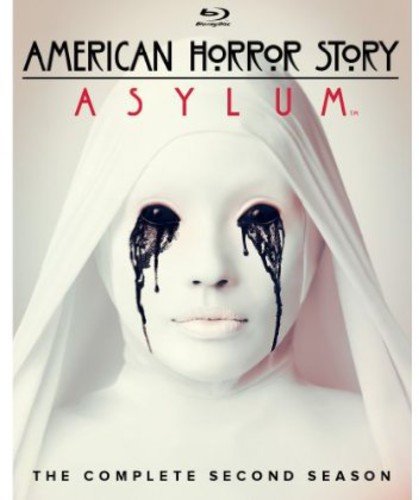
American Horror Story is more about horror than it is horror. It has the tropes, and the imagery, of real horror, but it is so completely saturated with these familiar aspects that it doesn’t manage to ever be too terribly scary. Fortunately, that is not all the show wants, or needs to accomplish.
Asylum, the second season of AHS, is a completely distinct story from the first season. Gone is the thoroughly annoying Harmon family, along with the rubber man and the psychic Downs syndrome next door neighbor. Asylum takes place, appropriately, in an asylum, run by the harsh to the point of sadism Sister Jude, played by Jessica Lange. Many of the main characters in the series are played by actors from the first season – it is a kind of repertoire company, filling in the roles of the horror-henpecked victims of AHS‘ latest terrible innovations.
Our ostensible hero is Kit Walker, who is accused of being the serial killer Bloody Face. He, sensibly enough, blames an alien abduction for the death and beheading of his wife. Beyond aliens and serial killers, there are mutated humans, demonic possession, medical experiments, amputations, human skin lampshades, Adam Levine, Nazis, evil Santas, bad seed child murderers and other horrors, and that is all in the first half of the season. American Horror Story‘s narrative strategy seems to be “Why stop with the kitchen sink?” That includes characters as well as plot lines.
There are at least four main characters: Sister Jude, her nemesis the nefarious and secretive Dr. Arden (a perfectly sinister James Cromwell), Kit, and Lana Winters, a reporter who sees too much and ends up incarcerated due to her “sexual inversion” (she’s a lesbian). And, though the main action of the series is set in 1964, there is also a wrap-around story about the modern day adventures of Bloody Face. There’s also the monsignor who dreams of being the first American pope, and a state psychiatrist who’s appalled by the conditions in the asylum, but has a few secrets of his own to keep.
That American Horror Story Asylum has two dozen plates spinning at once should be no surprise; the first season was about as overstuffed with weirdness as any show can be. What is surprising is how well it all works. While some elements only last an episode, they all fit inside the world that AHSA creates. Moreover, despite their weirdness, the ongoing plot lines tap into emotional cores. Lana is abandoned by everyone who loves her, Kit is wrongly accused and starts to doubt his own reality, Jude is underappreciated and desperate for some control of her life. There’s another inmate, Grace, who is apparently not insane and who gravitates toward both Lana and Kit. All of them are pitted against the twin terrors of Sister Jude and Dr. Arden, who uses the meek Sister Mary Eunice as a kind of emotional pinball until her encounter with a possessed boy leaves her profoundly changed. Between them, they make the already dank asylum a hellhole of abuse, experimentation, and eventually murder. And then things get really weird.
Remarkably, this season of AHS is able to take all of these disparate elements seriously within the context of the show. This does not mean that it is a serious show about Things with a capital T. An undercurrent of pregnancy terror runs all through this season and was a major theme of the first season as well. The inherent and infinite corruptibility of institutions, government, religious, scientific, and even the personal are on display, and no character comes out unscathed. Even as the last two episodes move away from the asylum and point toward the possibility of redemption, the show still has some twists to pull off.
American Horror Story: Asylum performs the rare feat of being as insane as it sounds. Most strange shows either disappear inside their own mythology, or maintain a level of weirdness for its own sake. They play fast and loose with their own rules, and use incoherence as a close second to actual weirdness. AHSA is, for all its madness, internally coherent. It creates an isolated world (though a deeply layered and, as I’ve said, deeply weird world) and then plays largely by the rules it establishes.
There is nothing perfect about this season. There’s plenty of clunky dialogue (Lana Williams gets more than her share, when the writers mistake ‘smart-assery that no human being would ever actually say’ for ‘smart’) and a few of the abrupt shifts in characterization, though motivated by the story, are a little too broad to be convincing. Not every plot-line pays off in a satisfactory way, but with dozens of them in a season, how could they? AHSA spends mosts of its time throwing newer, weirder things at the audience; what’s remarkable is how much of it actually sticks.